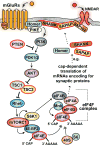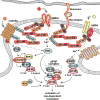Reciprocal signaling between translational control pathways and synaptic proteins in autism spectrum disorders
- PMID: 25351249
- PMCID: PMC6002803
- DOI: 10.1126/scisignal.2005832
Reciprocal signaling between translational control pathways and synaptic proteins in autism spectrum disorders
Abstract
Autism spectrum disorder (ASD) is a heterogeneous group of heritable neurodevelopmental disorders. Symptoms of ASD, which include deficits in social interaction skills, impaired communication ability, and ritualistic-like repetitive behaviors, appear in early childhood and continue throughout life. Genetic studies have revealed at least two clusters of genes frequently associated with ASD and intellectual disability: those encoding proteins involved in translational control and those encoding proteins involved in synaptic function. We hypothesize that mutations occurring in these two clusters of genes interfere with interconnected downstream signaling pathways in neuronal cells to cause ASD symptomatology. In this review, we discuss the monogenic forms of ASD caused by mutations in genes encoding for proteins that regulate translation and synaptic function. Specifically, we describe the function of these proteins, the intracellular signaling pathways that they regulate, and the current mouse models used to characterize the synaptic and behavioral features associated with their mutation. Finally, we summarize recent studies that have established a connection between mRNA translation and synaptic function in models of ASD and propose that dysregulation of one has a detrimental impact on the other.
Copyright © 2014, American Association for the Advancement of Science.
Figures


References
-
- Bourgeron T. A synaptic trek to autism. Curr Opin Neurobiol. 2009;19:231–234. - PubMed
-
- Fombonne E, Du Mazaubrun C, Cans C, Grandjean H. Autism and associated medical disorders in a French epidemiological survey. J Am Acad Child Adolesc Psychiatry. 1997;36:1561–1569. - PubMed
-
- Fombonne E. Epidemiological surveys of autism and other pervasive developmental disorders: an update. J Autism Dev Disord. 2003;33:365–382. - PubMed
Publication types
MeSH terms
Substances
Grants and funding
LinkOut - more resources
Full Text Sources
Other Literature Sources
Research Materials

